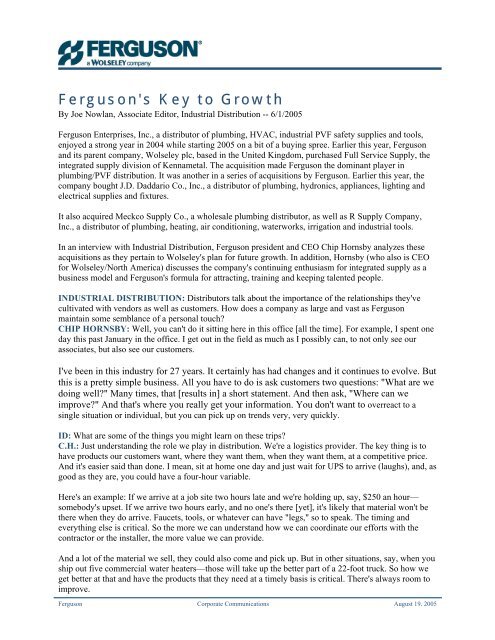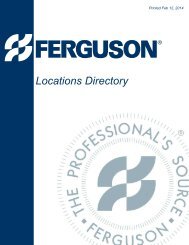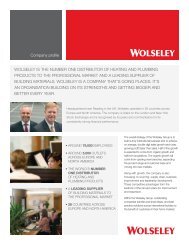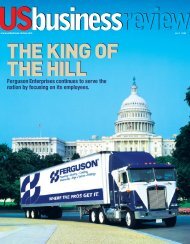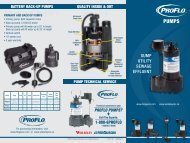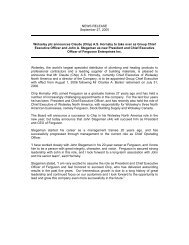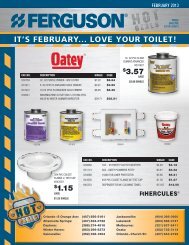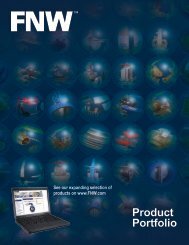Ferguson's Key to Growth - Ferguson Enterprises, Inc.
Ferguson's Key to Growth - Ferguson Enterprises, Inc.
Ferguson's Key to Growth - Ferguson Enterprises, Inc.
Create successful ePaper yourself
Turn your PDF publications into a flip-book with our unique Google optimized e-Paper software.
<strong><strong>Ferguson</strong>'s</strong> <strong>Key</strong> <strong>to</strong> <strong>Growth</strong>By Joe Nowlan, Associate Edi<strong>to</strong>r, Industrial Distribution -- 6/1/2005<strong>Ferguson</strong> <strong>Enterprises</strong>, <strong>Inc</strong>., a distribu<strong>to</strong>r of plumbing, HVAC, industrial PVF safety supplies and <strong>to</strong>ols,enjoyed a strong year in 2004 while starting 2005 on a bit of a buying spree. Earlier this year, <strong>Ferguson</strong>and its parent company, Wolseley plc, based in the United Kingdom, purchased Full Service Supply, theintegrated supply division of Kennametal. The acquisition made <strong>Ferguson</strong> the dominant player inplumbing/PVF distribution. It was another in a series of acquisitions by <strong>Ferguson</strong>. Earlier this year, thecompany bought J.D. Daddario Co., <strong>Inc</strong>., a distribu<strong>to</strong>r of plumbing, hydronics, appliances, lighting andelectrical supplies and fixtures.It also acquired Meckco Supply Co., a wholesale plumbing distribu<strong>to</strong>r, as well as R Supply Company,<strong>Inc</strong>., a distribu<strong>to</strong>r of plumbing, heating, air conditioning, waterworks, irrigation and industrial <strong>to</strong>ols.In an interview with Industrial Distribution, <strong>Ferguson</strong> president and CEO Chip Hornsby analyzes theseacquisitions as they pertain <strong>to</strong> Wolseley's plan for future growth. In addition, Hornsby (who also is CEOfor Wolseley/North America) discusses the company's continuing enthusiasm for integrated supply as abusiness model and <strong><strong>Ferguson</strong>'s</strong> formula for attracting, training and keeping talented people.INDUSTRIAL DISTRIBUTION: Distribu<strong>to</strong>rs talk about the importance of the relationships they'vecultivated with vendors as well as cus<strong>to</strong>mers. How does a company as large and vast as <strong>Ferguson</strong>maintain some semblance of a personal <strong>to</strong>uch?CHIP HORNSBY: Well, you can't do it sitting here in this office [all the time]. For example, I spent oneday this past January in the office. I get out in the field as much as I possibly can, <strong>to</strong> not only see ourassociates, but also see our cus<strong>to</strong>mers.I've been in this industry for 27 years. It certainly has had changes and it continues <strong>to</strong> evolve. Butthis is a pretty simple business. All you have <strong>to</strong> do is ask cus<strong>to</strong>mers two questions: "What are wedoing well?" Many times, that [results in] a short statement. And then ask, "Where can weimprove?" And that's where you really get your information. You don't want <strong>to</strong> overreact <strong>to</strong> asingle situation or individual, but you can pick up on trends very, very quickly.ID: What are some of the things you might learn on these trips?C.H.: Just understanding the role we play in distribution. We're a logistics provider. The key thing is <strong>to</strong>have products our cus<strong>to</strong>mers want, where they want them, when they want them, at a competitive price.And it's easier said than done. I mean, sit at home one day and just wait for UPS <strong>to</strong> arrive (laughs), and, asgood as they are, you could have a four-hour variable.Here's an example: If we arrive at a job site two hours late and we're holding up, say, $250 an hour—somebody's upset. If we arrive two hours early, and no one's there [yet], it's likely that material won't bethere when they do arrive. Faucets, <strong>to</strong>ols, or whatever can have "legs," so <strong>to</strong> speak. The timing andeverything else is critical. So the more we can understand how we can coordinate our efforts with thecontrac<strong>to</strong>r or the installer, the more value we can provide.And a lot of the material we sell, they could also come and pick up. But in other situations, say, when youship out five commercial water heaters—those will take up the better part of a 22-foot truck. So how weget better at that and have the products that they need at a timely basis is critical. There's always room <strong>to</strong>improve.<strong>Ferguson</strong> Corporate Communications August 19. 2005
ID: <strong>Ferguson</strong> recently purchased Full Service Supply from Kennametal. What has that brought <strong>to</strong><strong>Ferguson</strong>?C.H.: It's about a $130 million—plus business. FSS is integrated supply but a little different format thanwhat we have had. They're focused primarily by product, particularly in the area of cutting <strong>to</strong>ols. We sellcutting <strong>to</strong>ols at our integrated operation, but also sell everything else you might consider as "indirectspend." ...It doesn't have <strong>to</strong> be an industrial material. If it's something [the cus<strong>to</strong>mer] want <strong>to</strong> s<strong>to</strong>ck, werecapable of doing that, depending on their cus<strong>to</strong>mer base. Most of what we're selling is industrial supplies,but it could be office supplies, for example. What we're able <strong>to</strong> do [now] is take the service aspect, i.e. theprocess we have <strong>to</strong> supply different products and services—with [FSS] expertise around products, andblend the two <strong>to</strong>gether and hopefully strengthen the whole organization on both sides. It gives us a higherlevel of expertise and more cus<strong>to</strong>mers <strong>to</strong> be associated with.... So we're beginning <strong>to</strong> look for ways we[<strong>Ferguson</strong> and FSS] can work <strong>to</strong>gether. I just got back from Canada, where FSS has an operation, andwe're going <strong>to</strong> be able <strong>to</strong> work with [<strong><strong>Ferguson</strong>'s</strong>] Canadian operation <strong>to</strong> support FSS fully. We'rebeginning <strong>to</strong> see, particularly from a distribution process, that there's a lot of opportunity for us <strong>to</strong>leverage the supply chain even further.ID: Are these acquisitions a reflection of the <strong>Ferguson</strong>/Wolseley philosophy?C.H.: Absolutely. We've indicated that, from an acquisitions standpoint—and this is for all of Wolseley,not just in North America—that we hope <strong>to</strong> be able <strong>to</strong> spend roughly $450 million on an annualized basison acquisitions. And some years we've exceed that, other years we've fallen short. But on average, we'vebeen pretty close <strong>to</strong> that for the past five years or so....But we also have a huge emphasis on organic growth as well. It has <strong>to</strong> be a combination....We envisionthere are three ways <strong>to</strong> grow the business. Same s<strong>to</strong>re sales or organic growth, meaning doing more out ofour existing locations. Then, acquisitions. And the last piece is what we call business development—going in<strong>to</strong> markets where we don't operate <strong>to</strong>day, getting that market information, determining what thecompetitive environment is, and then going in and opening from scratch if an acquisition is not available.Chicago was a perfect example. We did that in the past 15 months. We went in there cold turkey and it'sbeen very successful for us....The businesses and services we provide for our target, our market—we're still in the single digit range ofmarket share, say, 8 <strong>to</strong> 9 percent. So the way we look at it, for everything that was sold yesterday, wedidn't sell over 90 percent of it. We didn't <strong>to</strong>uch it, so <strong>to</strong> speak. So there's a lot of opportunity <strong>to</strong> grow.ID: So what is the future of integrated supply at <strong>Ferguson</strong>?C.H.: We still see it as a separate division [of <strong>Ferguson</strong>], a unique business model. The way we envisionintegrated—instead of being associated directly with <strong>Ferguson</strong>, [integrated supply] is associated directlywith the cus<strong>to</strong>mer. What I mean by that is, they go in and focus on a particular cus<strong>to</strong>mer and begin <strong>to</strong> getinvolved with all aspects of their indirect spend. They're not involved with what we do traditionally everyday—buying and selling, quoting and shipping. They're looking at ways <strong>to</strong> acquire product at the lowestcost possible and the most efficient format.... We don't see this business dying off. It may not be growingat rapid rates but we think there are a lot of opportunities <strong>to</strong> expand it even beyond the industrial markets.ID: <strong>Ferguson</strong> has developed a solid reputation for its employee training program. You'll be hiring morethan 1,000 people during this year, for example.C.H.: Yes, over 1,000 people this year. Our [training] program was put in place over three decades agoby my predecessor's predecessor, David Peebles. It started in the late '60s, and Charlie Banks, who Isucceeded, was one of the first trainees who went in<strong>to</strong> that program. I'm a product of the class of '78.Three of us [from that class] are still with the organization. The class that year was only 12! At that timewe were a much, much smaller organization.<strong>Ferguson</strong> Corporate Communications August 19. 2005


